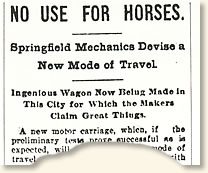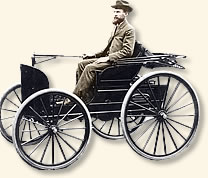|
America's First Automobile Race, 1895
Henry Ford receives most of the credit for
the development of the car in the US (see Henry Ford Changes
the World, 1908),
however, he did not produce the first American automobile. This distinction goes
to the Duryea brothers - Charles and Frank - who created their first gasoline-powered
"horseless-carriage" in
1893. Like the Wright brothers, the Duryeas were bicycle mechanics with a passion
for innovation.
 |
A Springfield newspaper announces
the appearance of the Duryeas' car
Sept. 16, 1893 |
The brothers built their first car in a workshop located in a building in downtown
Springfield, MA. Their new invention was rolled onto the city streets for testing
in September 1893. It sported a one-cylinder, gasoline engine and a three-speed
transmission mounted on a used horse carriage. It could achieve a top speed of 7.5
mph.
The following year, Frank developed a second car with a more powerful two-cylinder
engine. It was this car that he drove in America's first automobile race on
Thanksgiving Day, November 27, 1895. The race was sponsored by the Chicago
Times-Herald and ran a 54-mile course from down-town Chicago to Evanston, Il
and back.
There were five entrants in addition to Duryea: 2 electric cars and 3 gasoline-powered
Benz machines imported from Germany. The race started in the early morning
in snowy conditions. A little over 10 hours later, Frank Duryea was the first
to cross the finish line having survived a journey punctured by numerous breakdowns
and repairs. He had averaged 7.3 miles per hour and took home a prize of $2,000
($49,500 in today's money).
Frank Duryea described his experience in his autobiography:
"I now started with draughtsmen on plans for a new car, of
which I had, from time to time, been making rough sketches during the past
summer. But my work was interrupted by the necessity of preparing the old car
for the race promoted by H. H. Kohlsaat of the Chicago Times-Herald. This race
was set for November 2, and as driver, the Company sent me out to Chicago with
the car on that date. Only the Mueller Benz and the Duryea cars were ready
to start, so the race was postponed to Thanksgiving Day, November 28, 1895...
Thanksgiving Day, when it arrived, found me again in Chicago with the car...
A heavy snow had fallen during the night and we experienced hard going as we
drove out to Jackson Park from our quarters on Sixteenth Street.
Of nearly a hundred entries, only six cars lined up for the start. Of these six,
two were electric vehicles entered by Morris and Salom of Philadelphia, and
Sturgis of Chicago. Of the four gasoline-engined vehicles, H. Mueller & Go.
of Decatur, Illinois, R. H. Macy & Co. of New York, and The De la Vergne
Refrigerating Machine Co. of New York, each came to the start with an imported
German Benz. The Duryea Motor Wagon Company's entry was the only American-made
gasoline car to start.
The word ‘go’ was given at 8:55 and the Duryea was the first car
away.
With me as umpire was Mr. Arthur W. White. The machine made good going of the
soft unpacked snow in Jackson Park, but when we came to the busier part of
the city, the street surface consisted of ruts and ice hummocks, in which the
car slewed badly from side to side.
While still in the lead, the left front wheel struck a bad rut at such an angle
that the steering arm was broken off. This arm had been threaded and screwed
firmly to a shoulder, and it was a problem to extract the broken-off threaded
part of the arm. When this was finally accomplished, we, fortunately, located
a blacksmith shop where we forged down, threaded and replaced the arm.
 |
Charles Duryea in the brothers'
first car
|
While thus delayed, the Macy Benz passed us and held the lead as far as Evanston,
where we regained it.
Having made the turn at Evanston, elated at being in the lead again, we started
on the home trip.
We had not yet come to Humboldt Park when one of the two cylinders ceased firing...
This repair was completed in fifty-five minutes and we got going, feeling that
the Macy Benz must surely be ahead of us, but learned later that the Macy did
not get that far. Breaking the way through the snow in Humboldt and Garfield
Parks furnished heavy work for the motor, but also indicated that all competitors
were behind us.
After a stop for gasoline, and a four-minute wait for a passing train at a railroad crossing, we continued on to the finish in Jackson Park, arriving at 7:18 P.M.
The motor had at all times shown ample power, and at no time were we compelled to get out and push.
After receiving congratulations from the small group still remaining at the finish line, among whom were the Duryea Motor Wagon Company party, I turned the car and drove back to its quarters on Sixteenth Street.
The Mueller Benz, the only other machine to finish, was driven across the line at 8:53 by the umpire, Mr. Charles B. King, Mr. Mueller having collapsed from fatigue."
References:
Duryea's account appears in Duryea, Frank, America's First
Automobile (1942); Berkebile, Don H., The 1893 Duryea Automobile, Contributions
From the Museum of History and Technology vol. 240, Smithsonian Institution (1966).
How To Cite This Article:
"America's First Automobile Race, 1895", EyeWitness to History, www.eyewitnesstohistory.com
(2006).
|






